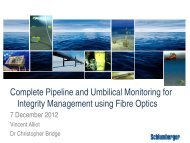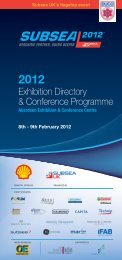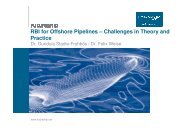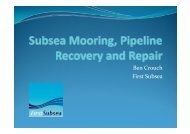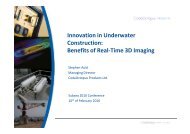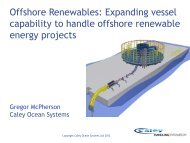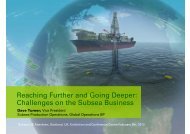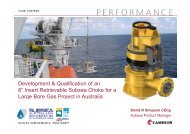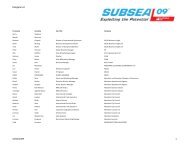Paul Hughes - Subsea UK
Paul Hughes - Subsea UK
Paul Hughes - Subsea UK
Create successful ePaper yourself
Turn your PDF publications into a flip-book with our unique Google optimized e-Paper software.
SUBSEA 2010<br />
Aberdeen, <strong>UK</strong><br />
<strong>Paul</strong> <strong>Hughes</strong><br />
‘Always Part of the Solution’<br />
paulh@firstsubsea.com<br />
.
Presentation Overview<br />
— First <strong>Subsea</strong><br />
— Field development and tie-backs<br />
— Flexible Risers and Umbilicals<br />
— Diverless Bend Stiffener Connector<br />
— Getting Connected:<br />
— BP Gulf of Mexico Fibre Optics<br />
— Neptune DWPP LNG Installation<br />
— Summary
First <strong>Subsea</strong><br />
— Formerly<br />
— Established in 1994<br />
— MBI in September 2001<br />
— Innovative design & engineering<br />
— Extensive Oil & Gas experience<br />
— QMS to ISO9001:2000<br />
— Representatives worldwide<br />
— Ball & Taper technology
Ball and Taper Principle<br />
— Simple mechanical mechanism<br />
— Individual multi-point grip<br />
— All grip elements are in compression<br />
— High load and fatigue resistance<br />
— Ball and Taper design is scaleable<br />
— Established and proven technology<br />
— Numerous applications worldwide<br />
— Mooring, pipelines, subsea connections
Field Development<br />
— Flexible risers and dynamic umbilicals<br />
are being deployed more readily into<br />
existing infrastructure as well as new<br />
field developments<br />
— Use of tie-back to existing facilities to<br />
optimise field performance, maximise<br />
marginal fields and develop satellite<br />
fields<br />
— Increased offshore production capacity<br />
from floating and subsea assets<br />
— More efficient and transportion allow<br />
longer distances and larger tie-backs<br />
— Developing subsea production requiring<br />
increased control and communications.
Flexible Risers & Umbilicals<br />
— Flexibles replacing steel catenary<br />
risers (SCRs) in both tie-back and<br />
new installations<br />
— Greatly reduced time (and cost) of<br />
installation and vessel requirements<br />
— Ideal for shallow to ultra deep water<br />
applications<br />
— Proven riser technology along with<br />
ancillaries and installation<br />
methodologies<br />
— Increasing development of flexible<br />
risers and dynamic umbilicals<br />
— Suited to riser and umbilical<br />
deployment on crowded platforms
Diverless Bend Stiffener
Diverless Bend Stiffener<br />
— Developed for various flexible applications<br />
— Utilizing existing & proven technologies<br />
— Time & cost savings through:<br />
— Completely diverless operation<br />
— Quick & easy engagement<br />
— Simple release procedure<br />
— Minimal or ZERO ROV intervention<br />
— Optional pull-in systems & hydraulics
DBSC Arrangement<br />
I Tube or<br />
Female<br />
Pull In Wire<br />
I Tube or Receptacle<br />
Pull In / Termination Head<br />
Male Tool<br />
DBSC<br />
Spool Piece (optional)<br />
Interface<br />
Bend Stiffener<br />
BS Tip Clamp (optional)<br />
Flexible Riser / Umbilical
‘Type I’ DBSC Overview<br />
— Designed to suit existing I & J Tubes<br />
— Interface directly into I/J Tube bore<br />
— Retrofits into existing installations<br />
— Utilizing existing pipeline technology<br />
— No diver intervention required<br />
— Minimum ROV intervention<br />
— Hydraulic activation & setting<br />
— Secured with hydraulic pre load<br />
— Controllable engagement<br />
— Mechanical locking system
‘Type II’ DBSC Overview<br />
— Two part (Male/Female) design<br />
— Developed for new build applications<br />
— Flanged or welded to I/J Tube fabrication<br />
— Optimising I/J Tube & flexible dimensions<br />
— Machined receptacle grooves & stop<br />
— Designed to reduce bending moment<br />
— Requires NO diver or ROV intervention<br />
— Utilizing proven Ballgrab technology<br />
— Simple mechanical operation<br />
— Reduced size, weight & cost<br />
I Tube Interface<br />
Receptacle -<br />
(End Stop)<br />
(Internal Groove)<br />
Guide Cone<br />
Male Tool -<br />
(Nose)<br />
(Mandrel)<br />
(Springs)<br />
(Flange)<br />
Adaptor Flange<br />
Bend Stiffener
DBSC Installation<br />
Type I DBSC<br />
Type II DBSC
DBSC Installation – ARC/SPR<br />
— Auto Release Clamp (ARC)<br />
— Integrated within Type II DBSC<br />
— Completely ROV-less System<br />
— New patent pending<br />
— Shear Pin Release (SPR)<br />
— Existing installation philosophy<br />
— Use with Type I OR II DBSC<br />
Adaptor Flange<br />
End Fitting<br />
Shear Pin<br />
Receptacle Stop<br />
DBSC Nose
DBSC Disconnection<br />
— Alternative release mechanisms :<br />
— ROV/Diver installed release clamp<br />
— Mechanical release / manual override<br />
— Integrated hydraulic system<br />
— Established disconnection methodology :<br />
— Support DBSC/BS assembly using clamp (or similar)<br />
— Clamp DBSC flanges using release mechanism<br />
— Clamping DBSC disengages balls from I Tube<br />
— DBSC free to be lowered from receptacle / I Tube<br />
— Designed to suit access restrictions
DBSC Design Verification<br />
— Joint development with Trelleborg<br />
— DNV verified fatigue testing regime<br />
— Ultimate Load State (ULS) testing :<br />
— Axial Load<br />
— Bending moments & shear force<br />
— Torque<br />
— Pull-in load testing & misalignment<br />
— Extensive FAT / SIT simulations<br />
— Customer & development testing<br />
— Ongoing research & development
Tyco/BP - Gulf of Mexico<br />
— Part of a 1,400 km subsea fibre optic<br />
communications network tie-back<br />
— Connection of BP Spars (2007/8):<br />
— Holstein (10 ID I Tube)<br />
— Horn Mountain (14.5 ID I Tube)<br />
— Mad Dog (16 ID I Tube)<br />
— Existing I/J tubes with Bellmouths<br />
— 450 deep diverless connection in<br />
1,325 1,650m W/D<br />
— Type I DBSC design employed
Neptune LNG Project<br />
— Neptune Deep Water Port Project (DWPP)<br />
North and South buoys in 80m W/D<br />
— APL Submerged Turret Loading (STL)<br />
— Four Type II DBSCs installed<br />
— Female connector integrated into STL buoy<br />
construction during design and fabrication<br />
— Male connector installed on flexibles:<br />
— Gas Riser (467mm) into 30 J tube<br />
— Control Umbilical (102mm) into 10 I tube<br />
— Quick Diver/ROVless installation
DBSC Summary<br />
— Developed for all types of Flexible Riser<br />
and Dynamic Umbilical applications<br />
— Small footprint for crowded platforms<br />
— Safe installation, time & cost savings<br />
— Minimal or ZERO ROV intervention<br />
— Optional pull-in system & hydraulics<br />
— First <strong>Subsea</strong> / Trelleborg partnership<br />
— Utilizing existing proven technologies<br />
— Maximising deployment opportunities
<strong>Paul</strong> <strong>Hughes</strong><br />
paulh@firstsubsea.com<br />
‘The innovator of engineering<br />
excellence, specializing in<br />
connection and mooring solutions’




